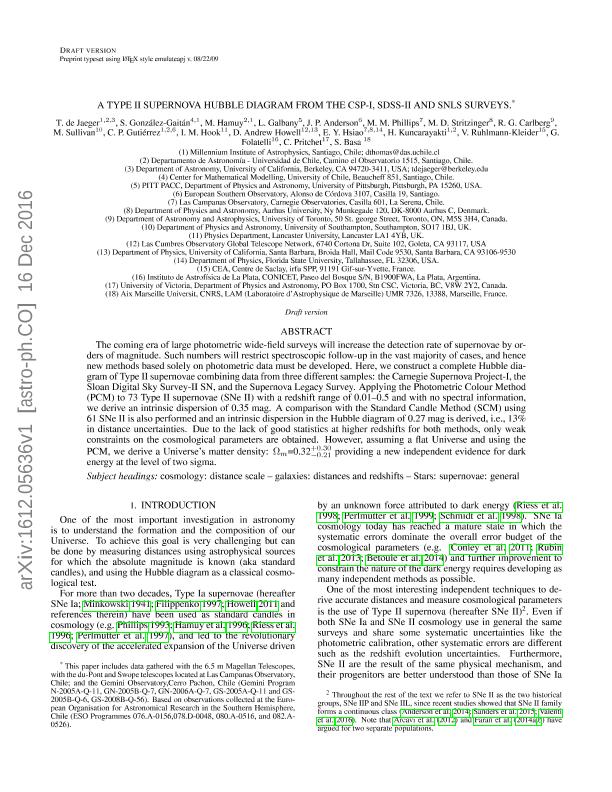Mostrar el registro sencillo del ítem
dc.contributor.author
Jaeger, T. De
dc.contributor.author
González Gaitán, S.
dc.contributor.author
Hamuy, M.
dc.contributor.author
Galbany, L.
dc.contributor.author
Anderson, J. P.
dc.contributor.author
Phillips, M. M.
dc.contributor.author
Stritzinger, M. D.
dc.contributor.author
Carlberg, R. G.
dc.contributor.author
Sullivan, M.
dc.contributor.author
Gutiérrez, C. P.
dc.contributor.author
Hook, I. M.
dc.contributor.author
Howell, D. Andrew
dc.contributor.author
Hsiao, E. Y.
dc.contributor.author
Kuncarayakti, H.
dc.contributor.author
Ruhlmann Kleider, V.
dc.contributor.author
Folatelli, Gaston

dc.contributor.author
Pritchet, C.
dc.contributor.author
Basa, S.
dc.date.available
2018-04-06T14:59:51Z
dc.date.issued
2017-02
dc.identifier.citation
Jaeger, T. De; González Gaitán, S.; Hamuy, M.; Galbany, L.; Anderson, J. P.; et al.; A type II supernova Hubble Diagram from the CSP-I, SDSS-II, and SNLS surveys; IOP Publishing; Astrophysical Journal; 835; 2; 2-2017
dc.identifier.issn
0004-637X
dc.identifier.uri
http://hdl.handle.net/11336/41103
dc.description.abstract
The coming era of large photometric wide-field surveys will increase the detection rate of supernovae by orders of magnitude. Such numbers will restrict spectroscopic follow-up in the vast majority of cases, and hence new methods based solely on photometric data must be developed. Here, we construct a complete Hubble diagram of Type II supernovae (SNe II) combining data from three different samples: the Carnegie Supernova Project-I, the Sloan Digital Sky Survey II SN, and the Supernova Legacy Survey. Applying the Photometric Color Method (PCM) to 73 SNe II with a redshift range of 0.01-0.5 and with no spectral information, we derive an intrinsic dispersion of 0.35 mag. A comparison with the Standard Candle Method (SCM) using 61 SNe II is also performed and an intrinsic dispersion in the Hubble diagram of 0.27 mag, i.e., 13% in distance uncertainties, is derived. Due to the lack of good statistics at higher redshifts for both methods, only weak constraints on the cosmological parameters are obtained. However, assuming a flat universe and using the PCM, we derive the universes matter density: m= 0.32 m+0.30 - 0.21 providing a new independent evidence for dark energy at the level of two sigma.
dc.format
application/pdf
dc.language.iso
eng
dc.publisher
IOP Publishing

dc.rights
info:eu-repo/semantics/openAccess
dc.rights.uri
https://creativecommons.org/licenses/by-nc-sa/2.5/ar/
dc.subject
Distances (Galaxias)
dc.subject
Supernovae
dc.subject
Distance Scale
dc.subject
Galaxies
dc.subject
Redshifts
dc.subject.classification
Astronomía

dc.subject.classification
Ciencias Físicas

dc.subject.classification
CIENCIAS NATURALES Y EXACTAS

dc.title
A type II supernova Hubble Diagram from the CSP-I, SDSS-II, and SNLS surveys
dc.type
info:eu-repo/semantics/article
dc.type
info:ar-repo/semantics/artículo
dc.type
info:eu-repo/semantics/publishedVersion
dc.date.updated
2018-03-26T14:39:21Z
dc.journal.volume
835
dc.journal.number
2
dc.journal.pais
Estados Unidos

dc.description.fil
Fil: Jaeger, T. De. Millennium Institute Of Astrophysics; Chile. University of California at Berkeley; Estados Unidos. Universidad de Chile; Chile
dc.description.fil
Fil: González Gaitán, S.. Millennium Institute Of Astrophysics; Chile. Universidad de Chile; Chile
dc.description.fil
Fil: Hamuy, M.. Universidad de Chile; Chile. Millennium Institute Of Astrophysics; Chile
dc.description.fil
Fil: Galbany, L.. University of Pittsburgh at Johnstown; Estados Unidos. University of Pittsburgh; Estados Unidos
dc.description.fil
Fil: Anderson, J. P.. European Southern Observatory Santiago; Chile
dc.description.fil
Fil: Phillips, M. M.. Las Campanas Observatory; Chile
dc.description.fil
Fil: Stritzinger, M. D.. University Aarhus; Dinamarca
dc.description.fil
Fil: Carlberg, R. G.. University of Toronto; Canadá
dc.description.fil
Fil: Sullivan, M.. University of Southampton; Reino Unido
dc.description.fil
Fil: Gutiérrez, C. P.. European Southern Observatory Santiago; Chile. Millennium Institute Of Astrophysics; Chile. Universidad de Chile; Chile
dc.description.fil
Fil: Hook, I. M.. Lancaster University; Reino Unido
dc.description.fil
Fil: Howell, D. Andrew. Las Cumbres Observatory Global Telescope Network; Estados Unidos. University Of California, Santa Barbara; Estados Unidos
dc.description.fil
Fil: Hsiao, E. Y.. Las Campanas Observatory; Chile. University Aarhus; Dinamarca. Florida State University; Estados Unidos
dc.description.fil
Fil: Kuncarayakti, H.. Universidad de Chile; Chile. Millennium Institute Of Astrophysics; Chile
dc.description.fil
Fil: Ruhlmann Kleider, V.. Cea Saclay; Francia
dc.description.fil
Fil: Folatelli, Gaston. Consejo Nacional de Investigaciones Científicas y Técnicas. Centro Científico Tecnológico Conicet - La Plata. Instituto de Astrofísica La Plata. Universidad Nacional de La Plata. Facultad de Ciencias Astronómicas y Geofísicas. Instituto de Astrofísica La Plata; Argentina
dc.description.fil
Fil: Pritchet, C.. University Of Victoria; Canadá
dc.description.fil
Fil: Basa, S.. Laboratoire D'astrophysique de Marseille; Francia
dc.journal.title
Astrophysical Journal

dc.relation.alternativeid
info:eu-repo/semantics/altIdentifier/doi/http://dx.doi.org/10.3847/1538-4357/835/2/166
dc.relation.alternativeid
info:eu-repo/semantics/altIdentifier/url/http://iopscience.iop.org/article/10.3847/1538-4357/835/2/166/meta
Archivos asociados
